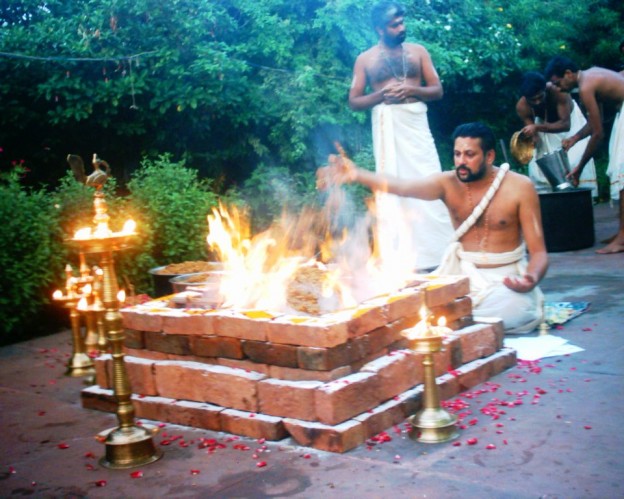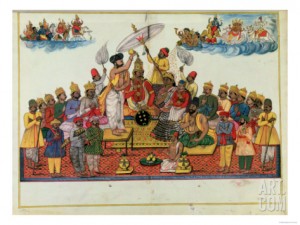Soma: the Lost Hindu Entheogen in a Social Context
For centuries, soma has been a compelling mystery to Western scholars and, drawn by the allure and mystique stemming from their conception of the religious purpose of intoxicants, they then proceeded to set down accounts of this bizarre drug of the Hindus. The fascination with this ritual narcotic is typical to the Western tradition of rejecting the potential religious properties of biological substances, of gaping at the natives with their strange, “ungodly” practices, while deifying an alcoholic liquid made from fermented grapes as the symbol of their dogma’s redeemer.
But what is soma? Where did this term and concept originate? When explored deeper than surface level, the clarity of the term soma becomes elusive and related to manifold Hindu traditions and experiences. Soma is seen as a god in some legends, while being lauded as a miracle substance in the Ninth Mandala of the Rigveda. A pervasive idea in Hindu religiosity, soma is both a mystery and a very real part of spiritual life in India. The trinity of somatic theory, in the form of godhead, a naturally occurring life form and strictly prepared substance is the relationship that remains unexpanded upon and, for the most part, ignored.
The idea of entheogens is not as foreign as many modern subscribers to myriad sects feel it may be; almost every culture has its own biological source that can induce godly interaction. An entheogen is simply a substance that may evoke or directly cause religious experiences. From peyote and auyhuasca, to Moses’s divine interactions atop Mount Sinai—a fertile ground for psychoactive flora—entheogens are present in nearly every incarnation of spirituality, and soma functions in this capacity. Alternatively described as hallucinogenic, stimulative or simply a source good fortune, soma is therefore treated in many different ways in Hindu practice.
According to the section of the Mahabharatha concerning the “Churning of the Seas of Milk”, Soma is not a substance at all. The Soma of this legendary epic is a god, a rare masculine lunar deity, counterpart to the many cultures who view the moon as inherently feminine. The concept of a male moon god is contained in Indo-European, with the moon still being viewed as masculine in Germany. Soma as a moon god is viewed as a powerful and high-ranking deity in the Hindu cosmology and is present in many epics, myths and religious observances.
This brings us to the very real, very tangible soma that is consumed or used in a ritual function throughout various Hindu practices, stemming all the way back to the Rigveda. The Ninth Mandala, or Soma Mandala, is a portion of the Rigveda devoted to praising the properties of soma. This refers to the plant used in a ceremonial context, specifically in the practice of soma yajna. Yajna refers to a broad class Vedic sacrifice, proscribed in the Vedas and observed by certain brahmin priests. The ceremony has changed over the years, but still preserves the historical or mythical traditions of yore. Only select members of the priest class would be authorized to perform a soma yajna in orthodox Hindu belief systems, as this offering to the gods must be kept unpolluted by using the dharmic idea of the brahmins’ purity. For this reason, the orthodox Vedic ritual is led only by those whose caste identity is deemed acceptable. The first soma yajna performed outside of India occurred in London in July of 1996. The sacrificer, or “yajamana” selected to officiate over the proceedings was Gosvami Gokulotsavaji Maharaj, a proponent of a movement to share Vedic ritual with cultures outside of India, and was selected by a committee; the organizer of the event was a famous Vedic scholar, Agnihotram Ramanuja Tatachariar. Gokulotsavaji Maharaj is the head of a Krishna devotee sect with large numbers of practitioners currently living in Britain. Obviously, these men are considered authorities on the subject of soma yajna as performed in this context, and were specifically vetted and chosen to be the face of this classical ritual performance in a highly public light.
While these strict traditions tend to hold sway, interesting examples of the laxation of this ritual have occurred: for example, monetization of this ancient practices have emerged, such as Vidwan Krishna, who offers to perform soma yajna in your name for a nominal donation. Due to the apocryphal nature of the exact biological identity of the species used for this practice, restrictions have slackened until soma can be any yellow hued plant. One famous traveller and scholar, Swami Rama, had the opportunity to visit Vaidya Bhairavdutt, a herbalist of high repute considered the last traditional expert on soma. In his autobiography, he discusses taking part in the consumption of what Bhairavdutt declared to be the original biological soma plant. Swami Rama recounts that shortly after imbibing a preparation of the plant, Bhariavdutt “started chanting and swinging, and ultimately threw off all his clothes and started dancing. But I had a severe headache…as though my head were going to blow up” (Rama 261). This experience is interpreted as signs and side effects of ephedrine overdose by many contemporary somatic scholars, which aligns with certain theories of the true biological identity of soma.
Care must be taken to elucidate a confusing dichotomy in the somatic concept: that the nectar of immortality, or amrit, is a very different substance than the soma drink associated with Indra or mortal ritual. This is made extremely clear in the mythic text, as amrit emerges before and separate from the god Soma. Indra’s soma is thusly recognized as distinct from the nectar amrit and is used as a strong identifier of the god of rain and thunderstorms. In Buck’s Ramayana, we can see Indra’s soma treated as a godly beverage reminiscent of the Greek concept of ambrosia, with seemingly alcoholic connotations. For example, during the Battle of Heaven, when Indra and Chitraratha are preparing to charge Ravana and his rakshasa troops, Indra “drank soma of his Soma” (Buck 44) and releases a fearless battle cry. Chitraratha is not feeling as confident as Indra, so he says, “‘Give me some of that juice.’ [and] he drank Indra’s Soma bowl dry in one swallow” (Buck 44). This is reminiscent of the amphetamine-esque properties described in parts of the Ninth Mandala, as Indra here is using his soma in a similar context to the warriors who would imbibe the preparation before entering a melee.
The duality of Indra’s soma and the practice of soma yajna can be explored through common religious artwork motifs. Below is a reproduction of an image on display at La Biblioteque Nationale in Paris entitled “Indra, King of the Gods, Being Anointed with Soma.”
Notice the two sources from which the eponymous soma stems from: on high, a host of deities emerge riding their heavenly mounts, scattering drops of golden liquid from their lofty domain; and the collection of crowned noblemen and brahmin priests preparing a soma drink from vessels depicted overflowing with a green herb, the soma plant, which has been transmuted into a gleaming offering of their own in the course of the sacrifice. This is part of a tradition of clear distinction between the two separate forms of soma. The Vedic soma prepared by priests is imbued with different purposes and characteristics than those attributed to Indra’s drink of choice in the great Hindu epics.
Sharing the name of the biological source and the preparation seems to reference the word haoma, a ritual drink and species of similar importance in the religious sphere the Avestan-speaking ethnic group of the area that is now Iran. Avestan is the language used in the holy manuscript of Zoroastrian practice, and haoma plays a similar role in sacrifice and divine enlightenment or understanding as does its Hindu counterpart in the Rigvedas This is yet another example of the widespread history of entheogenic practices in religion of the region.
When examined in a modern, unbiased perspective, soma is much less like the mysterious intoxicant written about by hundreds of years ago Western scholars agog at a religious observance considered taboo or different from their own. While their research was not constructed in the same social context as this study, we must never the less give them credit where it is due, as without Western scholastic interest, we would most likely know far less about Hinduism today than we currently do. As a salute to their quest for biological identification, several links to popular theories will be included at the bottom of this blog.
Soma is an extremely pervasive and functional concept in Hinduism, no matter which incarnation the term refers to. Beyond the concept of the dual identity of the soma preparation is the trinity of somatic idea. This is the relationships and differences between the god Soma, the plant soma and the processed liquid of the same name. The socio-religious context of soma is a rich ground for gleaning insight into the every day mechanisms of social factors in Hindu traditions.
Selected References on Biological Identity:
- McDonald, Andrew. “A Botanical Perspective on the Identity of Soma (Nelumbo Nucifera Gaertn.) Based on Scriptural and Iconographic Records.” Economic Botany, 147-73, 2004.
- McKenna, Terence K. Food of the Gods: The Search for the Original Tree of Knowledge : A Radical History of Plants, Drugs, and Human Evolution. New York: Bantam Books, 1992.
- Staal, Frits. “How a Psychoactive Substance Becomes a Ritual: The Case of Soma.” Social Research, 745-78, 2001.
Works Cited:
- Buck, William. Ramayana. Los Angeles: University of California Press, 1976.
- Rama, Swami. Living with the Himalayan Masters. Honesdale: Himilayan Institue Press, 2007.
- Smith, Frederick. “Indra Goes West: Report on a Vedic Soma Sacrifice in London in July 1996.” History of Religions, 247-67, 2000.
- Indra, King of the Gods, Being Anointed with Soma. Digital image: Art.com. La Biblioteque Nationale, n. d. Web. 14 Oct. 2014

